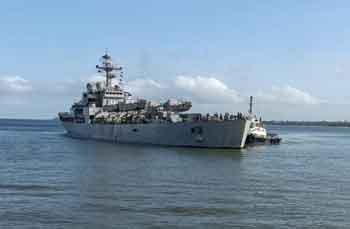Indian Naval Ship (INS) Mumbai made its inaugural visit to Colombo Port on Monday, marking a significant milestone in India-Sri Lanka maritime relations. This three-day visit underscores the ongoing maritime cooperation between the two neighboring nations. The INS Mumbai, a 163-meter-long destroyer, boasts a formidable crew of 410 members. This visit marks the first time the ship has docked at a Sri Lankan port, reflecting India’s deepening naval ties with the island nation.
Chinese Naval Presence at Colombo Port: A Ceremonial Arrival
In a coincidental yet strategic development, three warships from the Chinese People’s Liberation Army Navy (PLAN) also docked at Colombo Port on the same day. The Chinese vessels, He Fei, Wuzhishan, and Qilianshan, arrived on a ceremonial visit, showcasing China’s expanding naval influence in the Indian Ocean. These warships, varying in size and crew capacity, reflect the scale of China’s maritime capabilities. He Fei is a 144.50-meter-long warship with 267 crew members, while Wuzhishan and Qilianshan, each 210 meters long, carry 872 and 334 crew members, respectively.
Diplomatic Engagements and Strategic Interactions
Upon arrival, the Commander of INS Mumbai, Captain Sandeep Kumar, held a meeting with Rear Admiral Chintaka Kumarasinghe, Commander of the Western Naval Area, at the Western Naval Command Headquarters. This meeting highlighted the mutual respect and strategic dialogue between the Indian Navy and the Sri Lankan Navy, reinforcing the importance of such visits in enhancing regional security.
Strengthening Bilateral Ties Through Joint Activities
During its stay, the crew of INS Mumbai will engage in various joint activities with the Sri Lankan Navy, promoting camaraderie and cultural exchange. These activities include sports, yoga sessions, and coastal area cleaning initiatives, reflecting the broader commitment of both navies to environmental stewardship and people-to-people connections. These interactions not only strengthen military ties but also foster goodwill between the two nations.
Upcoming Naval Exercises: Enhancing Interoperability
On August 29, INS Mumbai will participate in a passage exercise with a Sri Lankan Navy ship off the coast of Colombo. This exercise aims to enhance interoperability and coordination between the two navies, crucial for maintaining regional maritime security. Such exercises are vital in preparing both navies for potential joint operations and in ensuring seamless communication during collaborative missions.
The Significance of INS Mumbai’s Visit
INS Mumbai, an indigenously built destroyer, was inducted into the Indian Navy on January 22, 2001. Its visit to Sri Lanka symbolizes India’s commitment to maintaining a strong maritime presence in the Indian Ocean, a region of increasing strategic importance. The ship’s presence at Colombo Port also serves as a reminder of India’s role as a key security partner for Sri Lanka and its readiness to support regional stability.
The Broader Implications of Concurrent Naval Visits
The simultaneous presence of Indian and Chinese warships at Colombo Port is a clear indicator of the strategic significance of Sri Lanka in the broader Indo-Pacific region. As both India and China seek to expand their influence in the Indian Ocean, Sri Lanka’s ports have become focal points for maritime diplomacy. This convergence of naval power highlights the island nation’s pivotal role in regional geopolitics, as it navigates the complex dynamics between its powerful neighbors.
Navigating a Complex Maritime Landscape
The docking of Indian and Chinese warships at Colombo Port on the same day is more than a mere coincidence; it is a reflection of the ongoing strategic competition in the Indian Ocean. As Sri Lanka continues to balance its relationships with India and China, these naval visits underscore the importance of maritime diplomacy in maintaining regional stability. For India, INS Mumbai’s visit is a testament to its enduring commitment to its neighbors, while for China, the arrival of its warships signifies its growing maritime ambitions. As both nations continue to assert their presence in the Indian Ocean, Sri Lanka remains at the crossroads of this evolving maritime landscape.
















